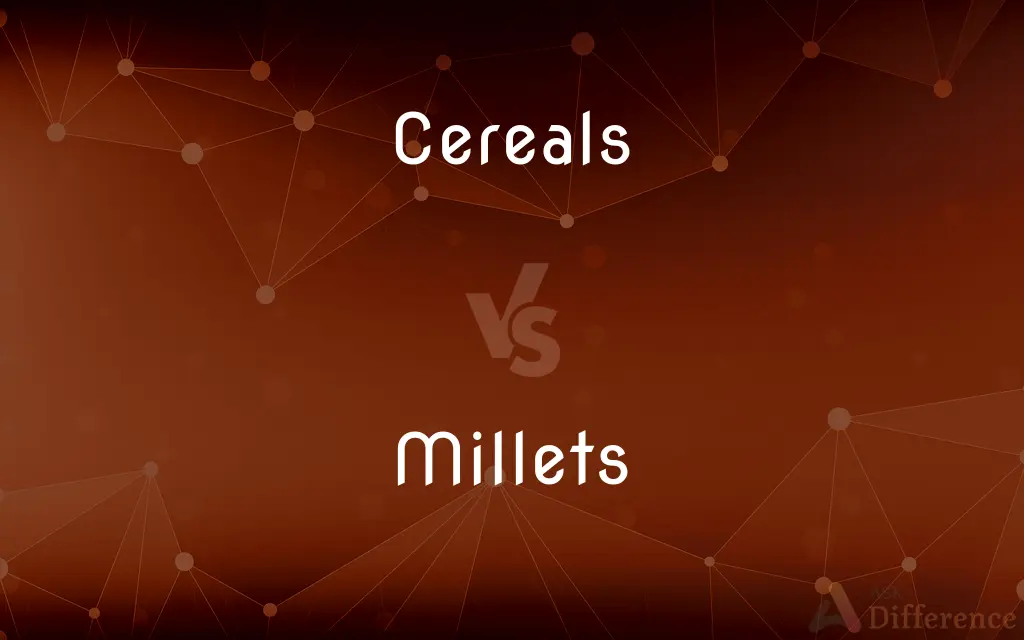Cereals vs. Millets — What's the Difference?
Edited by Tayyaba Rehman — By Fiza Rafique — Published on October 29, 2023
Cereals are grassy plants like wheat and rice, widely consumed staples, typically larger grains. Millets are a group of small-seeded, highly nutritious, and climate-resilient cereal crops.

Difference Between Cereals and Millets
Table of Contents
ADVERTISEMENT
Key Differences
Cereals are predominant staple foods, providing a significant source of calories worldwide. Millets, on the other hand, might not be as globally recognized but are fundamental in certain regions, providing essential nutrition. Cereals tend to have larger grains and include examples like wheat, rice, and corn, while millets have relatively smaller grains and varieties include foxtail, pearl, and finger millet.
Focusing on cultivation, cereals like rice often require a substantial amount of water for growth. Contrastingly, millets are renowned for their ability to withstand harsher environmental conditions, including drought and poor soil quality, proving to be quite resilient crops. Millets are often championed for their robustness, able to grow in areas where common cereals might struggle.
When considering nutritional content, cereals such as rice, especially white rice, may not be as nutritionally dense as millets. Millets are often hailed for their impressive nutritional profile, being rich in fiber, protein, and various essential minerals. This quality of millets makes them a potent nutritional source, especially in regions where they are primary staples.
Considering culinary uses, cereals are incredibly versatile, being used in various dishes from breakfast to dinner. Millets are also highly versatile but have been traditionally used in different manners across cultures, providing a base for porridges, flatbreads, and even fermented for beverages. Both cereals and millets offer a variety of culinary applications, though they might be different depending on cultural contexts.
Lastly, on a commercial scale, cereals, particularly wheat and rice, have a massive global market. Millets may not share the same widespread commercial use but are gaining attention for their nutritional and environmental benefits. Both cereals and millets have their own respective importance in global agriculture and nutrition, albeit in different scopes and scales.
ADVERTISEMENT
Comparison Chart
Grain Size
Typically larger
Smaller
Water Requirement
Generally higher
Drought-resistant, lower
Nutritional Value
Varied, can be less dense
Typically nutrient-dense
Global Recognition
Widely recognized
Less globally recognized
Examples
Wheat, rice, corn
Foxtail, pearl, finger millet
Compare with Definitions
Cereals
Cereals can be processed into various food products, including breakfast cereals.
Cornflakes are a popular breakfast cereal enjoyed globally.
Millets
Millets encompass a group of small-seeded cereal crops.
Finger millet is known for its rich calcium content.
Cereals
Cereals are edible grains obtained from cultivated grasses.
Rice and wheat are the most consumed cereals worldwide.
Millets
Millets have traditionally been vital in specific regional diets.
In India, millets have been a staple in various regional cuisines for centuries.
Cereals
Cereals are utilized in varied forms such as whole grains, flour, or meals.
Cereals like corn are often ground into meal for cooking.
Millets
Millets are typically high in fiber and other nutrients.
Millets are often recommended for their high nutritional value in dietary plans.
Cereals
Cereals can also refer to breakfast foods made from processed grains.
Many cereals are fortified with vitamins and minerals to enhance their nutritional value.
Millets
Millets can be utilized in a variety of culinary applications.
Millets can be ground into flour to create nutritious bread.
Cereals
A grass such as wheat, oats, or corn, the starchy grains of which are used as food.
Millets
Millets are known for their resilience and drought resistance.
Millets can yield crops even in poor soil conditions where other cereals might fail.
Cereals
The grain of such a grass.
Millets
Any of various annual grasses with small grains that are harvested for food, livestock feed, and birdseed, especially proso millet.
Cereals
Any of several other plants or their edible seeds or fruit, such as buckwheat or certain species of amaranth.
Millets
The grains of any of these plants.
Cereals
A food prepared from any of these plants, especially a breakfast food made from commercially processed grain.
Millets
Plural of millet
Cereals
Consisting of or relating to grain or to a plant producing grain.
Cereals
Plural of cereal
Cereals
Cereals serve as a primary source of energy in many diets.
Cereals like rice are a staple food in many Asian countries.
Common Curiosities
What are cereals commonly used for?
Cereals are commonly used as staple foods, found in products like bread, pasta, and breakfast cereals.
How are millets traditionally consumed in Africa?
In Africa, millets are often used in porridges, soups, and traditional brews.
Are millets gluten-free?
Yes, millets are naturally gluten-free grains.
Are cereals considered healthy?
Cereals can be healthy, providing essential nutrients, though processing and added ingredients can impact nutritional value.
What is a key nutritional benefit of millets?
Millets are rich in fiber, vitamins, and minerals, often regarded for their nutrient density.
How do cereals and millets differ in terms of cultivation?
Cereals often require more water, while millets are more drought-resistant and can grow in harsher conditions.
Can millets be used as a rice substitute?
Yes, millets can be cooked and used as a nutritious substitute for rice.
What is the shelf life of millets?
Millets, when stored properly, have a shelf life of approximately 6-12 months.
Do cereals include oats?
Yes, oats are considered a type of cereal grain.
What are some common dishes made with cereals?
Common dishes with cereals include bread, porridge, and pasta.
What is the most widely consumed cereal?
Rice is one of the most widely consumed cereals globally.
Are there different types of millets?
Yes, there are various types of millets, such as pearl, finger, and foxtail millet.
Can cereals be eaten uncooked?
Some cereals, like those in breakfast foods, can be eaten uncooked, while others like rice require cooking.
Is millet gaining popularity in western countries?
Yes, millets are gaining popularity in western countries for their nutritional benefits and gluten-free nature.
What is a globally recognized cereal crop?
Wheat is a globally recognized cereal, vital in various international cuisines.
Share Your Discovery

Previous Comparison
Relative Clause vs. Subordinate Clause
Next Comparison
Discount Store vs. Department StoreAuthor Spotlight
Written by
Fiza RafiqueFiza Rafique is a skilled content writer at AskDifference.com, where she meticulously refines and enhances written pieces. Drawing from her vast editorial expertise, Fiza ensures clarity, accuracy, and precision in every article. Passionate about language, she continually seeks to elevate the quality of content for readers worldwide.
Edited by
Tayyaba RehmanTayyaba Rehman is a distinguished writer, currently serving as a primary contributor to askdifference.com. As a researcher in semantics and etymology, Tayyaba's passion for the complexity of languages and their distinctions has found a perfect home on the platform. Tayyaba delves into the intricacies of language, distinguishing between commonly confused words and phrases, thereby providing clarity for readers worldwide.













































